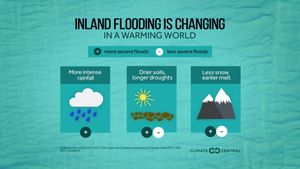LOS ANGELES — A catastrophic wildfire season has left the city reeling as two fierce blazes, the Eaton and Palisades fires, have become emblematic of both loss and accountability failures. These wildfires, which ignited on January 7, 2025, devastated thousands of homes, claimed lives, and raised serious questions about the readiness and response efficiency of California's emergency services.
After weeks of relentless fighting against the flames, firefighters achieved full containment on January 31, bringing some relief to terrified residents. Yet, the damage was already extensive. The Eaton Fire engulfed over 14,000 acres, destroying nearly 10,000 structures and resulting in at least 17 lives lost. The nearby Palisades Fire burned through 24,000 acres and caused at least another 12 deaths, marking these twin tragedies as some of the worst wildfires in Southern California's history.
Speaking on “The Brian Kilmeade Show,” former New Jersey Governor Chris Christie didn't hold back his criticism of California's leadership. He stated, "It's an enormous failure, Brian, and an enormous disappointment for the people of California and now a tragedy for all those families..." His remarks echoed the sentiment of many, highlighting the government's apparent lack of preparedness for such catastrophic events.
The fires were fanned by one of the most potent Santa Ana wind events seen in over ten years, with wind speeds reaching near 100 mph. Tragically, as firefighters scrambled to control the blazes, they faced significant obstacles stemming from low water pressure and hydrant failures. According to Rick Caruso, owner of the Palisades Village mall, "There’s no water in the fire hydrants." This alarming water shortage stemmed from years of mismanagement within the Los Angeles water supply infrastructure.
Janisse Quiñones, CEO of the Los Angeles Department of Water and Power (LADWP), explained the dire supply issues. "The hydrants are down," said one firefighter over the radio. The situation escalated to the point where emergency responders could do little to stop the advancing flames.
Governor Gavin Newsom acknowledged the systemic water issues during the crisis, labeling the loss of water pressure "deeply troubling" and pledging to investigate. "The loss of water pressure to some local fire hydrants during the fires and the reported unavailability... is deeply troubling..." Newsom stated. Despite the governor's efforts to deflect responsibility, Christie insisted, "when you're the governor of a state and a natural disaster happens, there is no one more accountable than you." His comments held weight as criticisms mounted around Newsom's failure to act decisively at the onset of the fires.
Even as recovery efforts commenced, many residents faced uncertain futures. The fires left countless individuals without homes to return to, with loss extending beyond bricks and mortar to cherished memories. Christie lamented, "It’s heartbreaking. The photo albums, the memories... those are things you can't replace." Not to mention, the losses for the region are estimated at $28 billion, marking it as possibly the costliest disaster the U.S. has ever faced.
The legal ramifications are beginning to surface as attorneys for the fire victims prepare lawsuits against utility companies they accuse of negligence. Southern California Edison, accused of sparking the Eaton fire, firmly denied any wrongdoing, citing equipment investigations still pending. Patrick McNicholas, one of the attorneys representing victims, stated, "This goes beyond a failure of responsibility; it is gross negligence..."
The water failed to meet the demand needed to fight the fires, conjuring doubts about the effectiveness of LADWP's operations — and these doubts were amplified by criticism from residents and former officials who claim systemic failures led to unnecessary loss. This stage of blame and loss prompts discussions about future infrastructure improvements aimed at fortifying the city against wildfires.
The devastation of entire neighborhoods and the staggering rise of wildfires amid climate change exacerbated conditions are calls for vigilance and accountability. With the rains will come mudslides and debris flows as residents confront the specter of Mother Nature’s wrath even after the flames are extinguished. The catastrophic events have set the stage for discussions on resilience, planning, and the urgent need for change.
California's history of wildfire management has come under increased scrutiny, with demands for reforms echoing through the community. The coming months will require reflection and adaptation, not just for the emergency responders but also for the infrastructures meant to withstand such extreme events. Failure to act could spell disaster for those living within the shadow of the next wildfire.



